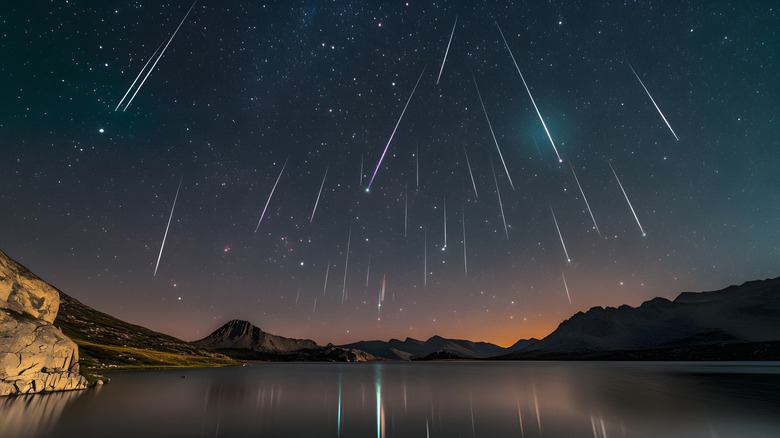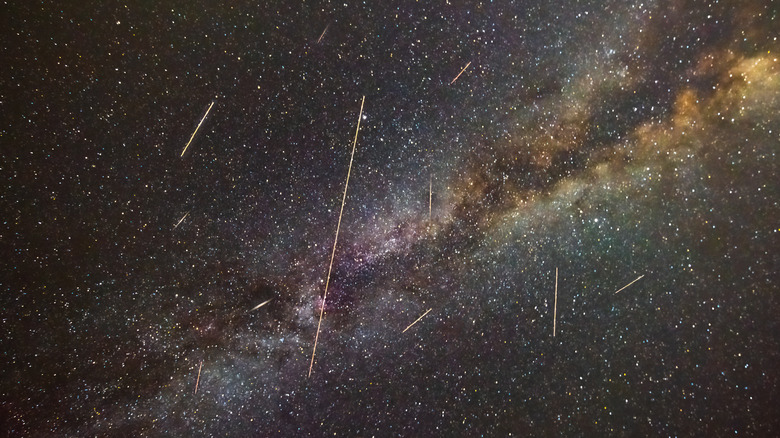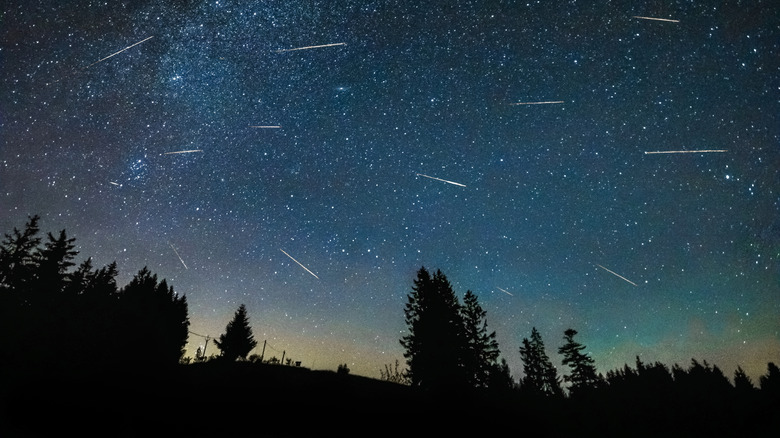The Magnificent 2025 Meteor Shower You'll Be Able To See Across America Very Soon
The Perseid meteor shower is widely considered to be the best meteor shower visible from Earth each year, and it's about to happen again. The 2025 edition of the annual event will begin on July 17, and last through August 23. Throughout this entire period, there will be a steady stream of shooting stars visible in the Northern Hemisphere. It's a must-see event for any astronomy enthusiast, and it comes by way of a spectacularly fortuitous cosmic occurrence.
As you read this, there is a comet whizzing through the solar system that is thought to be twice as large as the one that caused the mass extinction of the dinosaurs. It's called comet Swift-Tuttle, and fortunately for all of us, it's not on track to collide with Earth. The comet flies in an elliptical loop that takes 133 years to complete, and it last passed through the inner solar system in 1992, meaning it won't come close to us again until 2125.
As comet Swift-Tuttle makes its trek through space, it leaves behind a trail of rocky debris. Every summer, Earth's orbit takes us through a patch of that debris, causing thousands of tiny rock fragments to enter the atmosphere and subsequently plummet towards the ground in the spectacular display we call the Perseid meteor shower. It's a chance to see cosmic events in motion in a way like no other, and if you're worried about one of those meteors crashing to the surface, you don't need to be. Here's why.
Meteors vs. meteoroids vs. meteorites
The thought of thousands of cosmic rocks raining down through the atmosphere might sound incredibly dangerous at first, but Earth gets hit by a lot of space debris every single day, and it almost never does significant damage. The atmosphere protects Earth from these invaders, but for the meteors themselves, it's a different story.
It's time to talk about the difference between meteors, meteoroids, and meteorites. All three names could be applied to the exact same piece of space debris, but it depends on where it is located. When the icy rocks shed by comet Swift-Tuttle are floating about in space, they are known as meteoroids. When Earth passes through the debris field, some of those rocky bits enter the atmosphere, and when they do so, they become known as meteors, which move really, really fast. The average speed for a Perseid meteor is around 133,200 miles per hour. As they hurtle through Earth's atmosphere, meteors can reach temperatures over 3,000 degrees Fahrenheit, creating brilliant fireballs in the sky. The Perseid shower is famed for having especially bright fireballs.
If a meteor actually hits the surface of the planet, it becomes known as a meteorite. However, fewer than 5% of all meteors make it to the ground, as the vast majority disintegrate in the air due to intense heat and pressure. Every flash you see in the Perseid shower is a grain-sized fragment of space dying right before your eyes.
How to see the Perseid meteor shower this year
The Perseid meteor shower will last for over a month as Earth gradually moves through comet Swift-Tuttle's debris field. However, the showers peak in mid-August, when there will be an average of around 100 meteors falling each hour. The meteor shower can be viewed from as far south as the mid-southern latitudes, but it is most visible in the Northern Hemisphere, including across the United States. To see them for yourself, find the darkest patch of sky that you can access and look to the constellation of Perseus. The meteor shower is named after this constellation because it looks as if the meteors originate from it (the point from which meteors appear is known as a radiant).
Unfortunately, 2025 is set to be a lackluster year for viewing the Perseids. This is due to the full moon on August 9, just three days before the showers peak. This will make the night sky very bright at the time of the peak, making the meteors less visible than usual. So, this year, it's actually best to avoid the peak of the meteor shower and go looking between July 18 and 28. These are the days when the moon's cycle will be darkest, giving you the clearest view of the falling stars. And if you miss this year's shower, don't panic. The great thing about the Perseids is that we always meet up with them again every summer.


